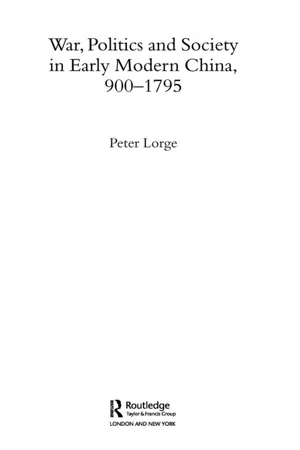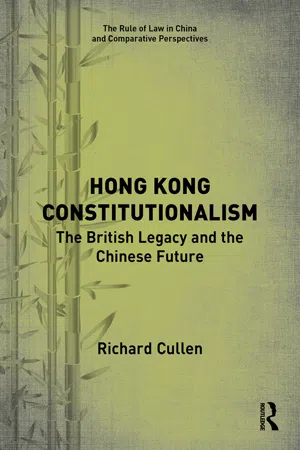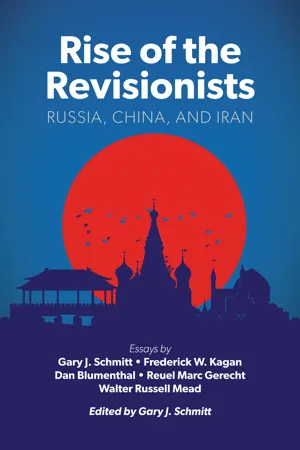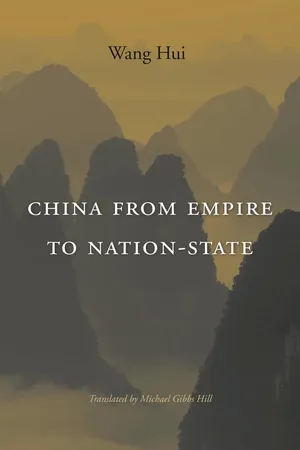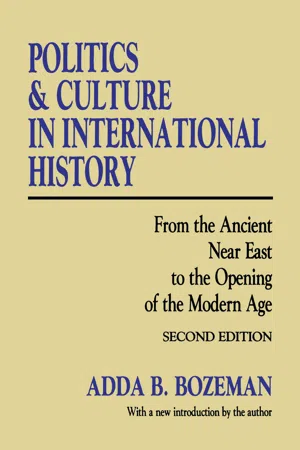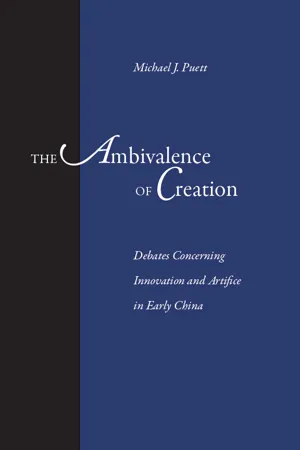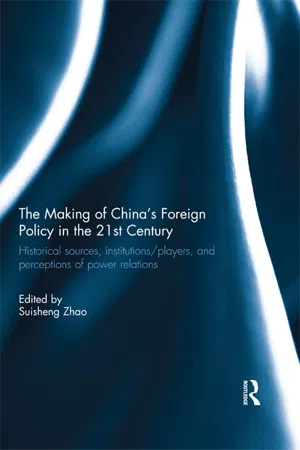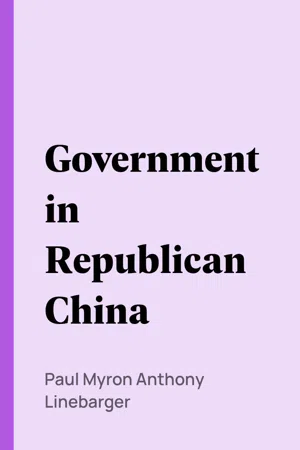History
Imperial China
Imperial China refers to the period of centralized, dynastic rule in China, characterized by a strong, authoritarian government and a highly structured social hierarchy. This era saw the construction of the Great Wall, the development of Confucianism, and the establishment of a vast bureaucracy. Imperial China lasted for over two millennia, with various dynasties ruling the region.
Written by Perlego with AI-assistance
Related key terms
10 Key excerpts on "Imperial China"
- Peter Lorge(Author)
- 2006(Publication Date)
- Routledge(Publisher)
2The traditional Chinese state (after 221 bce) has not been commonly characterized as martial or even imperial in the sense that it encompassed diverse lands and peoples who did not share its culture. It has most usually been portrayed as a civil-oriented bureaucracy, staffed by scholar-officials who qualified for their positions by passing rigorous exams, dominated by Confucian beliefs, and held together at the most basic level by a common Han Chinese culture which spanned most of the Chinese ecumene.3 While this picture is substantially correct in its particulars, it is incomplete and does not explain how the Chinese empire was repeatedly reconstituted in the last millennium of imperial history. By contrast, empires were more sporadic in South Asia, as shown by the Mauryan (322–184 bce), Gupta (320–550 ce) and Mughals (1526–1857);4 or in Europe, where, after the Romans, no one was able to build an empire of comparable territorial or cultural span for the lifetime of even a single conqueror. Rather than attempt to explain why South Asians and Europeans were so inept at South Asian and European empire building respectively, I will attempt to explain instead why the Chinese, Mongols and Manchus were so skilled at Chinese empire building.First and foremost, all of the successful imperial Chinese dynasts were extremely skilled in the use of war in state formation and maintenance. Chinese empires were not created by the cultivation of virtue, a fundamental cultural orientation to political order, or ideological pleas for ethnic unity; they were created by decades of war and political strife. Organized violence was applied toward political goals intelligently and ruthlessly, with the targets of that violence almost exclusively the power elite, the men and women who held significant political, military, cultural or economic power. (The actual effects of that violence, however, fell most often upon the farmers and ordinary people in the path of armies.) Although this has been most apparent during the rule of “alien” conquerors like the Mongols or Manchus, it has been equally true of the Han Chinese dynasts as well. All imperial dynasties were conquest dynasties.- eBook - ePub
Hong Kong Constitutionalism
The British Legacy and the Chinese Future
- Richard Cullen(Author)
- 2020(Publication Date)
- Routledge(Publisher)
1717 Michael, China through the Ages , 71. What is most striking is the way that this hierarchy did not give warriors a pre-eminent ranking as found in Ancient Greek and Roman civilizations, for example.Imperial durability
Professor Xu Chenggang explains that the Chinese Imperial system, which prevailed for well over 2,000 years, from 220 BC (Qin Dynasty) to 1912 (Qing Dynasty), lasted far longer than any other Imperial system.18 He goes on to argue that the basic institutional structure outlined above, with its central reliance on bureaucratic governance, provided the foundations for this unprecedented durability.19 There is also an important path dependency impact – this same system has had a lasting influence on today’s China.2018 Xu, Chenggang, “The Fundamental Institutions of China’s Reforms and Development” (2011) 49 Journal of Economic Literature, 1076.19 Ibid.20 Ibid.The average life of Chinese Imperial Dynasties was a remarkable 300 years.21 Unlike in Europe, emperors in China typically died, often of advanced age, in bed rather than more suddenly and violently.2221 Lau, Laurence J. “Comments on Chenggang Xu, ‘The Institutional Foundations of China’s Reforms and Development’”, available at: http://www.igef.cuhk.edu.hk/igef_media/people/lawrencelau/presentations/english/100127-1.pdf (accessed July 1, 2019).22 Xu, Chenggang, “The Origins and Evolution of China’s Institutions: A Comparative Institutional Analysis”, Presentation at Faculty of Law, Hong Kong University, April 19, 2017.Over 2,000 years ago China, during the Qin Dynasty, set down the foundations of a new, advanced governance system designed to manage a very large-scale, stabilized, agriculture-based empire. This was fundamentally a continental empire. War and conquest were features of this empire but not on the scale which typified the Roman Empire. Imperial domination of the agricultural economy kept the peasant farmers subjugated – but agriculture was not fundamentally slave-dependent as was the case in the Roman Empire. The macro or state-craft Confucian ideology in fact ranked the peasant farmers comparatively highly.23 - eBook - ePub
Rise of the Revisionists
Russia, China, and Iran
- Gary Schmitt(Author)
- 2018(Publication Date)
- AEI Press(Publisher)
Moreover, the CCP now openly celebrates China’s imperial past. Xi announced his new national plans at the national museum that now proudly exhibits China’s imperial history:The “revival” narrated in the museum exhibit is also built on a new kind of memory of China’s imperial past (from roughly 221 BCE to 1911). In the Mao era, China’s long dynastic history was usually denigrated as a time when the Chinese people suffered under the yoke of feudalism and the aristocratic, land-owning class—in league with the ruling imperial houses—oppressed the peasants. Today, this Maoist view of the imperial past has been replaced with a much more positive and lustrous image that reflects China’s new global, “imperial” aspirations in the present . . . what is being “revived” in China today is the greatness and ancient glory of China’s past lost to Western and Japanese imperialism. The restoration of Confucianism . . . both in Party and popular discourse, parallels this revisionist view of the imperial past.7What Is the Imperial Past? The Height of Chinese Power
To understand what the CCP is attempting to reclaim, one must understand China at the height of its power. Modern China’s boundaries are loosely based on those established at the peak of the Qing dynasty, which ruled from 1636 until 1911. The Qing dynasty was founded by the Manchus, a nomadic tribal people from the Asiatic steppe, who toppled the Ming dynasty (1368–1644), reconquered lost Ming lands, and expanded the Chinese empire.To expand outward from the Han heartland, successive emperors mounted military campaigns. Kangxi, the first great Manchu/Qing emperor, pushed the empire north, establishing new borders with Russia, fighting the Mongols, and stationing troops in Tibet.China had the unique ability to “Sinify” both peripheral territories and its own invaders, such as the Manchus. The Manchu ruling elite maintained a distinct identity from the Han Chinese, but they also adopted important dimensions of traditional Chinese political culture. They did this in part to pacify the majority Han population and in part because the Confucian political-social structure seemed an efficient means to rule an empire. - eBook - ePub
- Hui Wang, Michael Gibbs Hill(Authors)
- 2014(Publication Date)
- Harvard University Press(Publisher)
8In historical research on pre-nineteenth-century China, members of the Chinese gentry and Chinese scholars have always had misgivings about the concept of a “Chinese empire” so frequently applied by Western scholars. There are two sources for these misgivings. First, the majority of Chinese scholars do not agree that it is possible to discuss European empires and Chinese dynasties on the same terms, and argue that China and its world model largely depend on a model of assimilation through culture and ritual and “kingly transformation” (wang hua), through the virtue of the sovereign, of peoples from afar. According to this argument, China is different from empires based on military conquest such as the Roman Empire, Mongol Empire, or Ottoman Empire. Second, in a great number of its usages, the concept of empire has already been placed in a relationship of absolute opposition to the nation-state and even to modernity itself, and thus the designation of “empire” assumes in advance that Chinese society and culture is sealed off from the outside world, autocratic, and backward. Regarding the first point, many scholars who research the comparative history of empires have conceded that Chinese dynasties utilize Confucian scholars and the gentry class as a unique set of intermediaries, and that in the process of “kingly transformation,” “culture” plays a far more powerful role than military conquest. This point, however, is not enough to refute or reject wholly the application of the concept of empire: Where, after all, in the histories of the Qin, Han, Sui, Tang, Song, Yuan, Ming, and Qing dynasties do we see a lack of historical records of military conquest? Among those European empires or Asian empires that are strongly characterized by military conquest (e.g., the Roman Empire, Ottoman Empire, Mughal Empire), how many did not use a universal “civilization” to structure its vision of the world and its own legitimacy? The real problem is not the application of the concept of empire, but how to break apart the empire/nation-state binary, and how, when conducting historical research, to manage appropriately the relationships between the concept of empire and other historical Chinese political concepts—enfeoffment (fengjian), “grand unification” (da yitong), centralized administrative system (junxian), tribute, and so on—as well as historical differences between the various Chinese dynasties. Naitō Konan and Miyazaki Ichisada argued that the Song dynasty could be understood as a centralized administrative state that was similar to the nation-state (in terms of group identity, a community with defined limits, bureaucratic systems, trade relations, civic culture, etc.), and thus could be distinguished from political communities represented by dynasties such as the Han, Tang, Yuan, and Qing, which all held extremely large territories, contained a multitude of ethnic groups, and were dominated by an aristocracy with unlimited power. Compared to the Song and Ming dynasties, the Qing dynasty’s political structure, cultural ideology, and structures of ethnic groups all show a high degree of hybridity and limitlessness (this concept is understood relative to the clear boundaries of community established by the nation-state in terms of territorial borders and population). The Han, Tang, and Qing were all more similar to what is commonly understood as empire, and from the formation of their structures and institutions, we can describe some of their characteristics as follows: first, their hybrid systems and mechanisms of control are different from a pure system of enfeoffment (fengjian) or centralized administration structure (junxian). Second, they possess a society and economy of vast scope and a set of multinational ethnic relations that have been formed by military expansion, trade, and immigration. Third, they possess multiple structures of power, with concentrated central power and structures of power generated by local culture existing side by side. Fourth, they work to make their own culture universal or to serve as the representative of “civilization”; this type of universal culture or civilization, however, is characterized by its hybridity and is not monolithic. Following a groundswell of nationalism in the nineteenth century, the deep suspicion of this type of empire, with its multiple centers of power, multinational ethnic makeup, and limitlessness, came to serve as one historical justification for the legitimacy of the nation-state model. An unavoidable question remains, however: Since modern China was established on the historical foundations laid by the Qing dynasty, how are we to understand the continuities between “empire” (diguo) and “nation” (minzu) - eBook - ePub
- Michel Aglietta, Guo Bai(Authors)
- 2012(Publication Date)
- Routledge(Publisher)
3 and even potential foreign intrusions were contained most of the time. The claim of the emperor over the whole territory was absolute. And that was not just any territory. The imperial Chinese territory had no borders: it can be every inch of soil “under the heaven.” In the Chinese perception, whenever the Chinese government succeeded in incorporating a territory into the political and cultural order of Imperial China, it was considered part of the country. And, once it was integrated, the emperor would be the ultimate owner of this piece of land. This concept rooted out the possibility of unrestricted independent power of any locality, especially toward the later stages of the empire. In the early eras of Imperial China, central government still faced serious threats from overwhelmingly powerful localities. Some of them even enjoyed recognition from the central government. Han Gaozu, for example, rewarded his old comrades with large territories to govern. In the Tang dynasty, military towns also enjoyed strong autonomy. But, as imperial institutions evolved to their maturity, these cases became rarer over time. In the year 969, the first emperor of the Song dynasty eliminated the power of all the generals of the remaining autonomic military towns over a banquet. After that, independent local authorities in China totally died out.The emperor also had total control over taxation. No one else had the legal capacity to impose formal fiscal claims. Throughout Imperial China, fiscal revenue depended mostly on agricultural and poll taxes. In the later period the monopoly of salt also brought in considerable income. The composition of fiscal income reflects the agrarian economy of Imperial China as well as the political intention of the ruling house. Anchoring farmers as the major providers of fiscal revenue posed the least political threats to the emperor’s regime. Scattered, organically organized, small land-owning families had much less possibility of challenging the central regime than magnate families that possessed concentrated wealth and power. To illustrate this point, the European states could serve as a perfect counter-example. Confronted with continuous fiscal shortage because of heavy military expenditures, European states tended to seize as much fiscal resources as they could. However, as local aristocrats or clergies usually claimed land, agricultural tax collection was not always effective. Hence the ruling houses of Europe frequently relied on commercial taxes or fell prey to public debts. The result was either the loss of political independence of their regimes to the urban bourgeoisie and financiers, or endless expansion for new unclaimed resources. Chinese rulers suffered from neither of these outcomes. Even when China suffered fiscal crises, the government could still largely maintain the structure of its fiscal revenue. Thanks to the relatively small burden of military spending, Chinese royal houses were usually able to solve the problem of fiscal deficiency by shrinking expenditures. The most frequently applied measures included cutting administrative costs and subsidies for the royal family, as well as suspending large-scale constructions. Higher taxes would also be imposed in times of financial difficulty. Owing to an effective bureaucratic system and firm control over land, the imperial Chinese governments more or less succeeded in meeting their financial needs under such a land-based tax regime. The Song dynasty might be an exception. With constant military threats from the north, the Song dynasty relied on commercial sources, which provided over half of its administration’s fiscal income (Wong 1997 - eBook - ePub
Imperial China
The Historical Background to the Modern Age
- Michael Loewe(Author)
- 2021(Publication Date)
- Routledge(Publisher)
qua official rather than to his personal character or motives. But it is difficult to handle or evaluate the large volume of material whereby the history of institutions can be studied, as its arrangement is inconvenient and its compilers had no fully critical approach.I. FORM AND THEORY (A) THE CENTRAL GOVERNMENT
From its inauguration, imperial government has comprised two parts: the offices whose work concerned the whole of the Chinese empire, and which were situated in the capital city, and the organs of regional administration whose responsibility was limited to particular areas. These two parts can be described as the central government and the provincial authorities.The officers of the palace and the administrators of the empire
The central government of Imperial China has been formed of elements of entirely different sources which became inextricably associated together shortly after the formation of empire. Many of the principal offices of state had originated from the needs of the palace, i.e. the domestic services required to provide the kings of Ch’in, before the empire had been formed, with security and revenue, and to maintain their establishments in suitable states of dignity. When the palace developed to become the supreme seat of imperial authority, it carried with it some of the same offices; and these were destined to become major elements in central government. Other elements derived from offices which had also been evolved in pre-imperial times, but whose purpose lay in supervising the tasks of state administration. In imperial times these offices came to take a dominant position and to carry the highest responsibilities of state.The functions and concept of the emperor permitted the coexistence of both these types of senior official, i.e. those designed for the emperor’s personal service and those required to govern his subjects. Both Confucian and authoritarian theory envisaged an emperor whose role was inactive rather than positive; ideally his single, comprehensive command to his advisers was to maintain an ordered and fully harmonized control of the world, and from such an order there was to emerge the series of executive functionaries, each invested with authority of a defined scope, and empowered to exact obedience as necessary. But the emperor was also entitled to expect suitable care and attention for his person, and his advisers were obliged to provide him with appropriate comforts and adornments. The central government had therefore to include not only those executive offices which were founded to control the emperor’s lands and subjects, but also the organs that were necessary to protect the emperor from danger, to regulate his relations with other mortals and to supervise the arrangements of his household. - eBook - ePub
Politics and Culture in International History
From the Ancient Near East to the Opening of the Modern Age
- Adda B. Bozeman(Author)
- 2017(Publication Date)
- Routledge(Publisher)
Part II The Imperial Systems of China and Rome Chapter 4 The Place of the Chinese State in Asia A. The Chinese System of International Relations The contemporary image of “one world” has only recently begun to supersede the many separate world images that for a long time past have held the imagination of the world’s different peoples. But its competitive chances to influence the formulation of national policies have been impaired unduly by our tendency to link its evolution exclusively to the political history and philosophy of Western Europe. In the interest of reconstructing the records of international history and appraising realistically the present worth of the “one world” theme, it is therefore necessary to understand those visions of the universe which non-Western peoples have held for thousands of years. Just as medieval Europeans thought of themselves as constituting the center of world happenings, and as the Indians looked upon India as the chief country of the earth in relationship to which all other areas were uncivilized, so the Chinese regarded China as the sole world state and the center of all humanity. Every intellectual effort to understand the place of that “Middle Kingdom” in contemporary world affairs, be it as a member of twentieth century world organizations or as a participant in twentieth century Asian politics, should issue from a preliminary understanding of these views. Furthermore, Chinese interpretations of their place in the universe reflect certain incontestable facts. The record of Chinese history is longer than that of other existing states and it involves an immense expanse of land, a multitude of races, and many separate language groups. 1 China’s achievement in state building is also unique in the annals of government because her people have known not only how to consolidate their empire but how to maintain it with a steadily increasing population as a continuously identifiable going concern - eBook - ePub
The Ambivalence of Creation
Debates Concerning Innovation and Artifice in Early China
- Michael J. Puett(Author)
- 2002(Publication Date)
- Stanford University Press(Publisher)
CHAPTER 4
The Creation of Empire: The Emergence and Consolidation of Imperial Rule in China
In 221 B.C. the state of Qin overtook Qi, the last of the remaining states, and created the first unified empire in Chinese history. This was the culmination of a lengthy process that had started with the reforms of Shang Yang in the mid-fourth century B.C. and continued through the gradual growth of Qin economic and military power over the course of the third century B.C. Nonetheless, upon declaring the formation of a new dynasty, the Qin chose to emphasize the moment as a point of rupture—of radical discontinuity from the past. And although the Qin empire would in the end last for only fourteen years, the institutions forged by the first emperor would ultimately have tremendous longevity. Indeed, by the time empire became successfully consolidated under the reign of Wudi (r. 141—87) of the following Han dynasty, the state to a large degree resembled that which had been initially created by the Qin.During this period, from the first emperor’s establishment of empire to the consolidation by Han Wudi, the debates traced in the previous two chapters intensified. Did imperial institutions mark a radical break from the past? If so, in what ways, if any, could be they be considered legitimate? In this debate, the arguments that had developed over the previous two centuries were invoked and reworked with a greater sense of immediacy and urgency—by figures at the imperial court and by those outside it. Ultimately, the voices favoring imperial centralization won and formed an imperial ideology.The Creation of Empire: The Qin Dynasty
After 221 B.C., the Qin expanded the state system that had developed over the previous century and a half to rule over all of China. The Qin divided all of its lands into a system of commanderies under the direct control of the central court, formalized a universal legal code, and greatly expanded both the power of the state and the area of its domination. In direct contrast to the decentralized kingdom of the previous Zhou dynasty, the Qin created an empire.1 - eBook - ePub
The Making of China's Foreign Policy in the 21st century
Historical Sources, Institutions/Players, and Perceptions of Power Relations
- Suisheng Zhao(Author)
- 2018(Publication Date)
- Routledge(Publisher)
9The Chinese world order was an ethical hierarchy, maintained by the power of the Chinese civilization. Developed within Chinese cultural boundaries, many societies in East Asia were strongly influenced by the Chinese civilization, for example, by the Chinese ideographic writing system, the Confucian classical teachings, the official examination system, and the imperial monarchy and bureaucracy. Vietnam and Korea are good examples of long centuries of Chinese control and political and cultural influence. Their state structure and literature were patterned on China's example, and their written languages and spoken tongues were strongly influenced by the Chinese. Confucianism, along with its examination system, dominated their political and intellectual life. Even though some countries, such as Japan, never fell under China's political domination, they could not escape from the strong influence of Chinese culture. Japan adopted its character-based writing system from China during the period from the fourth to the sixth century AD. Knowledge of the Buddhist religion, also from China, reached Japan through Korea.China's relations with its neighbors were thus culturally superior–inferior. The superior Sinitic zone was at the center, including the core China proper and the most nearby and culturally similar tributaries, Korea, Annam (Vietnam) and the Ryukyu Islands, parts of which were in ancient times ruled by the Chinese empires. Tibet and Central Asia, whose cultural developments were more or less independent of Chinese civilization, were located next. At a further distance were outer barbarians ( ) or uncivilized people. The Chinese culture and civilization demarcated the boundary between China's sedentary agricultural society and the barbarian's nomadic steppe societies. Clear legal boundaries of jurisdiction did not exist. The ocean could not prevent Korea, the Ryukyus and the Southeast Asian kingdoms from coming to China to learn Chinese culture and to pay tribute. China's power, despite her continental orientation, extended culturally and sometimes politically to maritime nations.10 - eBook - ePub
- Paul Myron Anthony Linebarger(Author)
- 2012(Publication Date)
- Perlego(Publisher)
wang , or king), who claimed hegemony for an undetermined distance beyond the walls of the capital.In the twelfth century b. c. the Shang dynasty was overthrown by conquerors from the west, the Chou. The Chou dynasty bridges the gap between the semihistoric and the definitely historic period of Chinese antiquity. Under the Chou the chief features of Chinese social and intellectual existence took on clear form. From the Chou conquest and their attempts to establish stable government China derived striking social and political characteristics. One of the astonishing facts about early Chinese history is the manner in which the Chou rulers utilized propaganda to make their conquest secure, and in which their propaganda furnished dynamic concepts of Chinese social thought and development.The most important of these widely propagandized concepts was that of the Chinese Empire. The city of Shang had been the center of a dominion which could not possibly have included more than a fraction of what is known today as China. The civilized areas along the Yellow River were probably no larger than Palestine. Most of what is now China was conquered in succeeding centuries. Even in this small area, it is not known what relationship existed between the ruler of Shang and other rulers. The Chou monarchs built up the legend that the Shang rulers had occupied a position of primacy among the rulers of the civilized world, and then claimed the position themselves by right of succession through conquest. There was thus fostered the notion of one ruler, central and supreme.Secondly, the Chou themselves taught the doctrine of the right of revolution. They identified their god with the Shang god instead of declaring that their god had overwhelmed the other. They asserted that this one god had been displeased by the profligacy and wickedness of the Shang and had called upon the Chou to overthrow the Shang rulers. Both these theories, refined and amplified, became fundamentals of Chinese political thought in later ages.4
Index pages curate the most relevant extracts from our library of academic textbooks. They’ve been created using an in-house natural language model (NLM), each adding context and meaning to key research topics.
